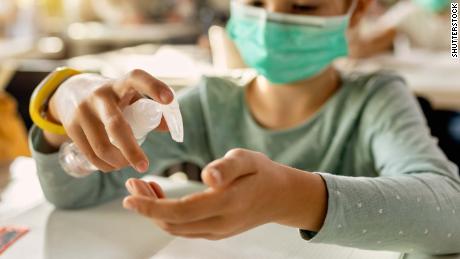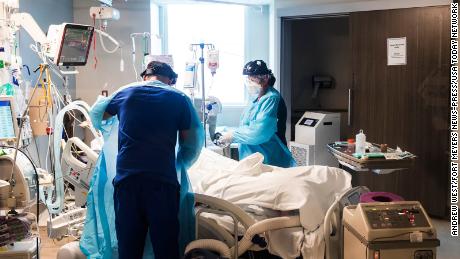The US is surpassing an average of 160,000 new Covid-19 cases a day, according to data from Johns Hopkins University. With the spread of the more transmissible Delta variant and many students returning to the classroom for a new academic year, the rise is concerning officials and health experts.
“First and foremost, if you are unvaccinated, we would recommend not traveling,” CDC Director Dr. Rochelle Walensky said at a White House COVID-19 Response Team Briefing on Tuesday.
Walensky said that while people who are fully vaccinated can travel with precautions, current transmission rates mean they too need to take Covid-19 risk into consideration when deciding whether to travel.
Health experts have said that vaccination is the best way to protect against the virus’ spread, and many have attributed the spike in cases to the large portion of Americans who are unvaccinated.
38.6% are not yet fully vaccinated, according to data from the CDC.
This week, data presented by a CDC vaccine adviser showed a hospitalization rate 16 times greater in the unvaccinated population than in those vaccinated. And the surge in hospitalizations, particularly among unvaccinated people, has stretched hospitals thin.
In Idaho, Gov. Brad Little said the state has reached a point in the pandemic “we have not seen before” with more Idahoans in the ICUs than ever before. He stressed multiple times that the “vast majority” are unvaccinated.
“Yesterday evening I toured a nearly full ICU wing in Boise. What I saw was heartbreaking,” he said Tuesday. “Some were young, two were middle-aged, two patients were pregnant… All of them were struggling to breathe and most were only breathing with help from a machine.”
He said medical staff are “exhausted,” so the state is adding up to 370 additional personnel to help.
A new case study published Tuesday illustrated the impact of gatherings of large groups of unvaccinated people.
In June, attendees met for a five-day overnight church camp and a two-day men’s conference in Illinois, neither of which required vaccination, testing or masks. By August, 180 Covid-19 cases were connected to the events, including five hospitalizations, according to the investigation, conducted by the CDC and the Illinois Department of Public Health.
More than 200,000 kids test positive in a week
Concern is growing over infections in children, many of whom don’t have access to the vaccine yet.
data published Monday by the CDC.
The result has been cases in children increasing “exponentially,” the American Academy of Pediatrics reported Tuesday.
More than 200,000 children tested positive for Covid-19 in the last week, a five-fold increase from a month ago, the AAP said. And rates of hospitalizations have risen with the cases.
Between August 20 and 26, an average of 330 children were admitted to hospitals every day with Covid-19, according to the CDC. That is the highest rate of new Covid-19 hospitalizations among children in more than a year, according to the CDC data.
An early goal of the vaccination effort was to administer enough protection to curb the spread in time for the new school year and allow students to return to the classroom safely — something many hadn’t done for a year.
But with cases on the rise, schools have had to implement other measures to protect students.
In New York, Gov. Kathy Hochul said Tuesday she plans to implement mandatory weekly Covid-19 testing for school staff who are not vaccinated.
“School staff, anybody who enters that building will have to be vaccinated or undergo mandatory testing — mandatory testing, and we’re in the process of getting the legal clearance for that, as I speak,” Hochul said.
“We’re not doing that well getting our 12 to 17-year-olds vaccinated, and they are vulnerable to the next virus, which is dangerous,” she said.
And while the US Food and Drug Administration has approved booster doses for adults, 12- to 17-year-olds are not able to get them yet. But Dr. Anthony Fauci, director of the National Institute of Allergy and Infectious Diseases, said this week he believes they will ultimately be eligible for boosters once the data is submitted to the FDA for safety considerations.
Hospitals running out of oxygen
Hospitals filling up with Covid-19 patients have put a strain on space and staffing, and many are now experiencing a shortage in oxygen supply.
Several hospitals in Florida, South Carolina, Texas and Louisiana are struggling with oxygen scarcity. Some are at risk of having to use their reserve supply or risk running out of oxygen imminently, according to state health officials and hospital consultants.
“Normally, an oxygen tank would be about 90% full, and the suppliers would let them get down to a refill level of 30-40% left in their tank, giving them a three- to five-day cushion of supply,” Donna Cross, senior director of facilities and construction at Premier, a health care performance improvement company, told CNN.
“What’s happening now is that hospitals are running down to about 10-20%, which is a one- to two-day supply on hand, before they’re getting backfilled.”
Even when they’re getting backfilled, it’s only a partial supply of about 50%, Cross said. “It is very critical situation.”
CNN’s Virginia Langmaid, Jennifer Hauser, Naomi Thomas, Lauren del Valle, Aya Elamroussi and Kristen Holmes contributed to this report.





